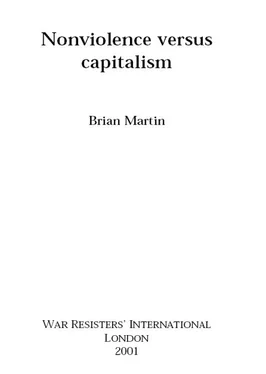What is needed is not theory from on high, developed by theoreticians and dispensed by movement gurus, but theory that can be used and refined daily by rank-and-file activists. [6] . This view is developed in Brian Martin, “On the value of simple ideas,” Information Liberation (London: Freedom Press, 1998), pp. 143-163.
Within some social movements, this occurs routinely. Many feminist activists have some familiarity with ideas from feminist theories, including some conception of patriarchy, alternatives and strategies; for this sort of “practical feminism,” much academic feminism is irrelevant.
Sometimes low-cost investigations can be carried out by participants. Investigations by activists are increasingly both possible and important. A search for information on the World Wide Web, plus sharing of information with other activists, can quickly lead to valuable material.
Within the nonviolence movement, there is a reasonable level of understanding of nonviolence theory, especially the methods and dynamics of nonviolent action. Nonviolence theory is an outgrowth of the practice of nonviolence and has not “gone academic” the same way as many other areas, perhaps because there are fewer careers to be made in the field. In order to apply nonviolence theory to capitalism, there needs to be a compatible analysis of capitalism, one that can be used by activists.
Analysing capitalism is a major enterprise. There are vast bodies of writing in various traditions, including neoclassical economics, Marxism and non-Marxist political economy. There are insights to be had for nonviolent activists, but to extract them is no easy task. Most of the writing is uncritical of capitalism, while most of the critical works give little attention to strategy for activists. There is a rich banquet for theorists, with only a few crumbs for activists.
Rather than sifting through analyses of capitalism, an alternative approach is to start with the alternative to capitalism and the method of obtaining it and build up activist-relevant theory from that. In the case of nonviolence, the alternative and the method are jointly specified: a nonviolent society created through nonviolent action.
That is the approach taken here. The starting point is nonviolence, which is both a method and a goal. “Nonviolence” is used in a broad sense, including participation and dialogue as well as lack of physical violence. Capitalism is analysed from the perspective of how it can be challenged and transformed using nonviolent action. Of course, it is useful to draw on some of the many insightful analyses of capitalism. But the key point is this: rather than develop a comprehensive analysis of capitalism first and then draw implications, instead critiques of capitalism are drawn on just to the extent that they are relevant for a nonviolent challenge. That means in addition that the analysis must be reasonably clear to activists. A high-level analysis understandable only to a few scholars is not much value except to the scholars themselves.
Needless to say, what I offer here is just one contribution to the process, which to be successful must involve many people grappling with ideas and using them in conjunction with practice.
In the spirit of activist-relevant analysis outlined above, chapter 2 deals with nonviolence, outlining methods, giving examples, presenting arguments for and against, and examining theory. For those who have been exposed to nonviolence theory and practice, this will be familiar ground.
Special attention is given to weaknesses of nonviolence, at a theoretical level, for challenging distributed systems of domination such as capitalism. The implication is that nonviolence theory must be supplemented by an appropriate analysis of the system being challenged. That may seem obvious, but in fact nonviolence theory relies on a very general theory of power and works reasonably well in practice only because many activists have a very good practical insight into local systems and dynamics of power. This combination works moderately well for obvious systems of domination, such as dictatorship, but for more dispersed systems of power such as capitalism, activists need deeper understandings.
With this background on nonviolence, chapter 3 looks at capitalism. Some of the obvious problems with capitalism are outlined, such as exploitation of workers, but only briefly.
The main part of the chapter describes three central aspects of capitalism that are specially relevant for developing a nonviolence strategy. The first is the most obvious: capitalism’s link with systems of violence, including government, the military and police. Without the ultimate sanction of violence, capitalism would not survive. But this reliance on violence is hidden through the routine operation of the market and needs to be brought into brighter view. Nonviolent action is ideally designed to challenge and undermine systems based on violence, so the key here is to design nonviolent actions that tackle the violent underpinnings of capitalism.
But although capitalism depends ultimately on violence, for most of the time it is sustained by belief systems and everyday behaviours, including those associated with consumerism, property, entitlement, individualism and selfishness. Challenging such beliefs and behaviours is a difficult task. Nonviolent action offers one approach, but not just any action will serve. Careful examination of options and alternatives is needed. It is in the area of beliefs and behaviours that the most effort is needed, especially because capitalism has an unparalleled capacity to coopt ideological challenges.
A third central aspect of capitalism that is specially relevant for developing a nonviolence strategy is destruction of alternatives. In the rise of capitalism, prior systems and alternative practices, such as community-controlled production, cooperatives and collective provision, were destroyed or marginalised. One reason why capitalism seems like the only option is that alternatives have been eliminated. Nonviolence strategy in this area is reasonably straightforward: it is the building of alternatives, in the tradition of Gandhi’s constructive programme. But this is not easy in the face of the power of capital to destroy and supplant alternatives.
Chapter 4 deals briefly with conventional anticapitalist strategies, especially Leninism and socialist electoralism, examining them through the lens of nonviolence theory. None of them has succeeded in permanently replacing capitalism with a better system, though it can be argued that social democracy has limited many of the worst capitalist excesses. From a nonviolence perspective, a central problem with these strategies is that they rely on the use of violence, namely the power of the state, for bringing about change. The existence of a system of violence means that it can be, and often is, used to support the powerful and repress challengers. Thus, these anticapitalist strategies have given only a limited amount of power to the people, retaining much power in the hands of a ruling group, whether it is communist party elites or politicians and bureaucrats in a social democratic government.
Taking note of these failed and flawed challenges to capitalism is especially relevant because some of the greatest hostility to nonviolent alternatives has come from socialists. It might be concluded that the collapse of communism has opened a tremendous opportunity. A nonviolent challenge to capitalism now has better prospects because the alternative socialist road, based on violence, is largely discredited.
Chapter 5 looks at nonviolent alternatives to capitalism, spelling out some possible principles for organising society without the capacity for organised violence. It turns out that there are not many comprehensive visions of society that are explicitly constructed on a nonviolent foundation. To illustrate possibilities, four models are outlined: sarvodaya, anarchism, voluntaryism and demarchy. By examining these, it becomes apparent how little of the current capitalist system is viable without the ultimate sanction of violence.
Читать дальше

![Brian Jacques - Martin the Warrior [Redwall 6]](/books/128385/brian-jacques-martin-the-warrior-redwall-6-thumb.webp)










